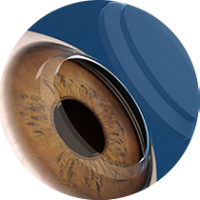Corneal Transplantation

You may have heard about someone having an eye transplant, but what exactly does that mean? Medical science has no way to transplant whole eyes at this time. One group of researchers hope to be able to perform whole eye transplants within a decade. However, when someone receives a transplant today, they are usually having a corneal transplant. Donor corneas make this amazing, sight-saving surgery possible.
Your eye is a complex organ connected to your brain by the optic nerve. The optic nerve sends visual signals from the eye to the brain, where they are interpreted as images. The optic nerve is relatively small, varying in length between 1.3 and 2.2 inches, and at its widest point inside your skull, it is still only a fraction of an inch wide. Yet the optic nerve is made up of more than one million tiny nerve fibers, much like a fiber optic cable. Once these nerve fibers are cut, they cannot be reconnected. That is why it’s impossible to transplant a whole eye. Even if a surgeon could implant the eye into the eye socket, the eye still would not be able to send signals to the brain through the optic nerve, and would not provide sight.
Corneal transplants
Corneal transplantation is not only possible, it has been used for nearly a century.
A healthy, clear cornea is needed for good vision. If your cornea is injured or damaged by disease, it may become swollen or scarred. This can cause glare or blurred vision. In a corneal transplant, a surgeon removes the damaged cornea and replaces it with a clear donor cornea. There are several corneal transplant surgery options available, depending on the situation.
Other eye-related transplants
Corneal transplantation is the most common type of eye transplant. But it is not the only one.
Sometimes, doctors can use part of a human placenta, donated after childbirth, to heal the cornea. They can use the innermost layer of the placenta, called the amniotic membrane, to create a healing bandage. This bandage can be temporary or permanent. These membranes help heal and regenerate surface tissues of the eye. This is called amniotic membrane transplantation (AMT), and it has been used for a long time to heal the sclera and the conjunctiva.
Surgeons have also been able to successfully perform eyelash transplantation. This can restore eyelashes lost due to burns, injury and other medical conditions.
Doctors continue to explore whether it is possible to transplant other parts of the eye. In July 2010, French doctors transplanted eyelids and tear ducts during a full-face transplant. Eyelids have been included in other face transplants in recent years as well.
Today, researchers are replacing damaged retinal cells with healthy transplants. In clinical trials, researchers have used human stem cells to grow retinal cells that are destroyed by conditions such as macular degeneration or Stargardt disease. One day these stem cells may be used to replace damaged retinal cells and treat these conditions.

